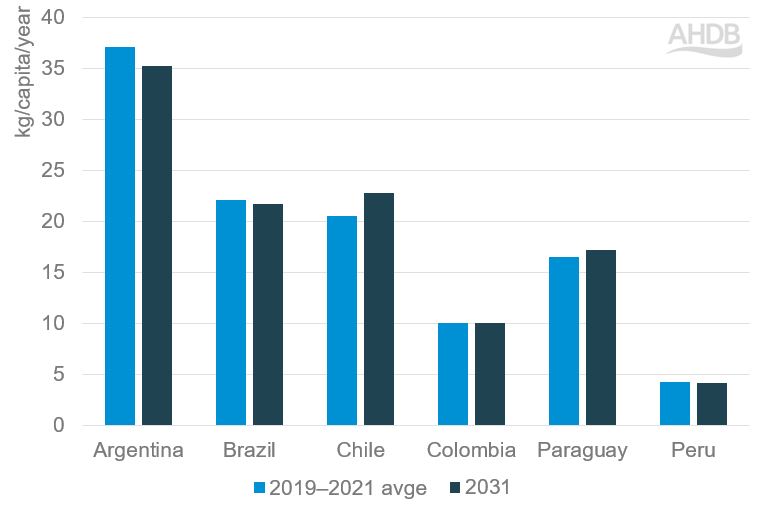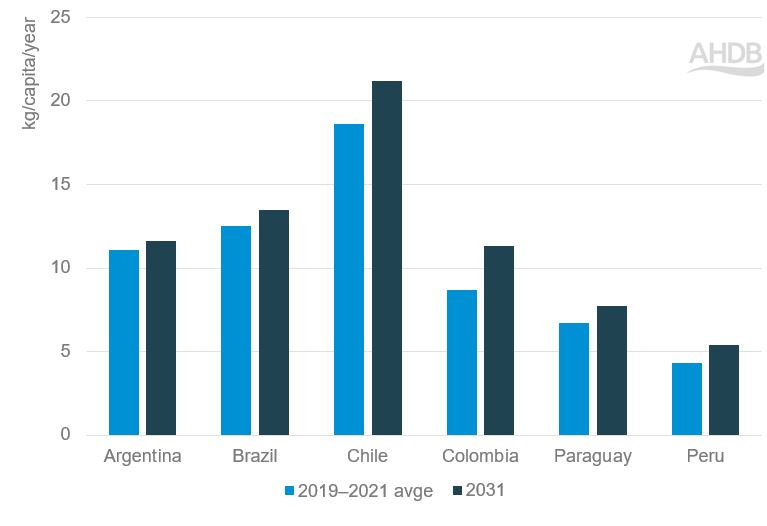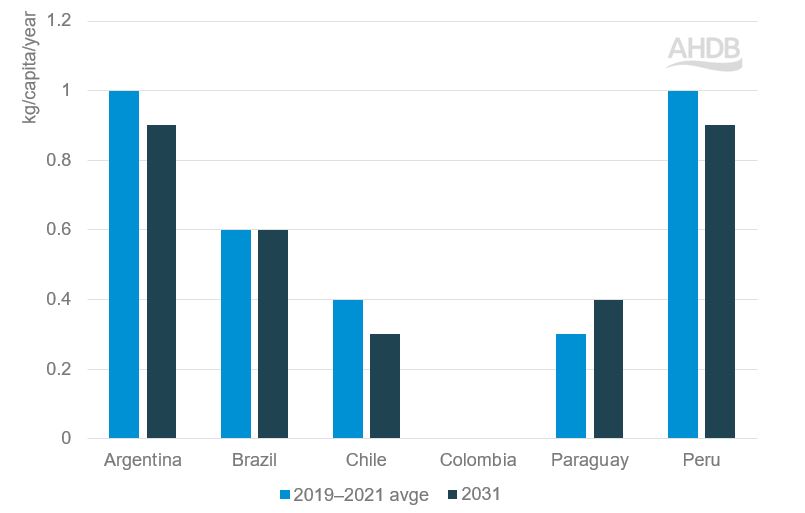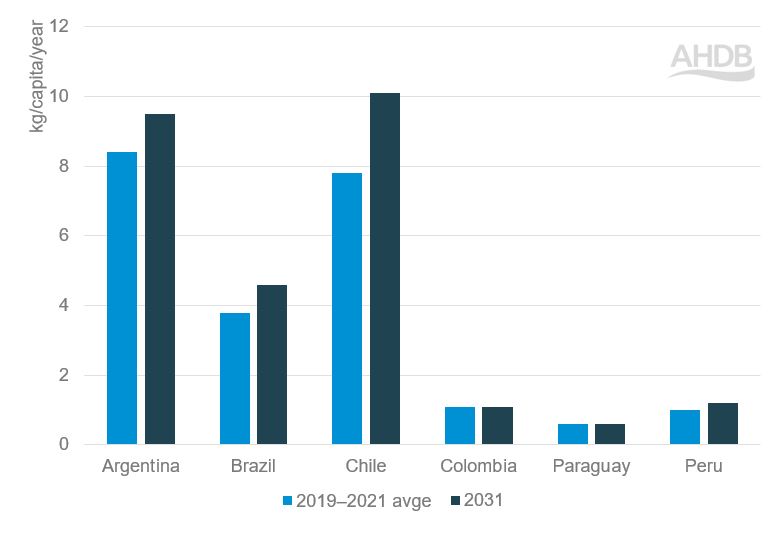- Home
- South America, Central America, Panama and the Dominican Republic: How much do they consume?
South America, Central America, Panama and the Dominican Republic: How much do they consume?
Meat consumption has been increasing among the middle classes in the region (the OECD includes Mexico as part of Latin America). Between 2019 and 2021 the average consumption was 61 kg per person per year, compared with the global average of 34 kg per person per year (Source: OECD).
Protein consumption in the region is expected to increase by 4% (to 89 g per person per day by 2031), driven by higher consumption of dairy products. Meat consumption is expected to increase by over 3%, to 63.4 kg per person per year in 2031 (Source: OECD).
Beef
The most popular red meat in South America and CAPDR is beef. Argentinians consume the most beef in the region, at 37.1 kg per person per year on average between 2019 and 2021. The largest growth in beef consumption by 2031 is expected to be in Chile, with a predicted increase of 11.2%.
Figure 1. Beef consumption per capita in selected South American countries

Source: OECD – FAO
Production of beef in South America and CAPDR is dominated by Brazil, with 8.7 Mt produced on average per year between 2019 and 2021; the other key suppliers are Argentina and the USA. The OECD projects Brazilian beef output to increase by 7% by 2031. Despite this increased production, Brazilian beef imports are forecast to rise by 5% over the same period.
Chile’s beef imports are expected to increase by 54 Kt (15%) by 2031 while Columbia’s imports are forecast to increase by 14 Kt.
Pork
Chileans consume the most pork in the region, at 18.6 kg per person per year on average between 2019 and 2021; this is expected to grow by 14% by 2031. The highest increase in pork consumption per person by 2031 is expected to be seen in Columbia (+30%), followed by Paraguay (+26%).
Pig meat consumption fell from 11.36 kg person per year in 2018 to 9.85 kg per person per year in 2020 in the Dominican Republic according to FAO data. While total domestic protein production has declined in the country since 2008, rising incomes and demand from a growing tourism sector is likely to continue to increase protein consumption (Source: USDA).
Figure 2. Pork consumption per capita in selected South American countries

Source: OECD – FAO
Brazil is the region’s leading producer of pig meat, with an average output of 4.3 Mt per year between 2019 and 2021. This is expected to increase by 8% by 2031.
In 2020, the Dominican Republic was 60% self-sufficient in pork production. However, production has been severely limited since 2021 due to an outbreak of ASF (African Swine Fever). This resulted in more than 60,000 pigs being culled, and it is likely that pork imports will increase. Although demand for pig meat declined during the months of August and September 2021 due to consumer concerns over ASF, it continues to be strong as Dominicans consume pork as their second main protein (after chicken) and also due to an 85% increase in tourists visiting the country (Source: USDA). In 2022, the UK exported over 1.2 Kt (value of £3.1 million) of pork to the Dominican Republic, the highest amount since exports to the country began in 2016. Total UK pork exports to the Dominican Republic (including offal) in 2022 were 5.4 Kt (value of £6.4 million). This represented an increase of 104% from 2021 in volume terms and 205% in value terms.
Chile and Colombia import large volumes of pork and this is forecast to grow further. The OECD projects Chile’s pork imports to increase by 20% (183 Kt) by 2031, compared with the 2019–2021 average. Columbia’s pork imports are forecast to increase by 57%, to just under 200 Kt, over the same period. Most of Chile’s pork imports come from Brazil and the USA, while Columbia’s main supplier is the USA.
According to the Peruvian Association of Pork Producers (Source: Asoporci), Peru imported 8.8 Kt of pork in 2019. Today, Spain, with a 12% share, ranks fourth in countries that export pork to Peru after Chile (36%), Canada (26%) and the United States (12%). In addition, communication campaigns on pig meat and production biosecurity have improved the knowledge of Peruvian consumers and reinforced their demands (Source: euromeat).
Sheep meat
Sheep meat is less popular than beef and pork within this region. The reasons for the low consumption of sheep meat range from the limited availability of the product on the market, to the lack of custom and lack of appropriate cuts for daily preparation. Also, the inadequacy of sheep meat for frequent consumption was identified as the main barrier, being considered a product for specific occasions, as opposed to daily meals.
Argentinians and Peruvians consume the most sheep meat in the region at 1 kg per person per year (2019–2021 average). This is expected to fall by 10% by 2031. Paraguay is the only country shown in Figure 3 where consumption is expected to increase by 2031.
Figure 3. Sheep meat consumption per capita in selected South American countries

Source: OECD – FAO
Official data does not give a true representation of sheep meat consumption in Chile. This is because a large proportion of sheep are not processed through Chile’s abattoirs, which means the meat is not included in official statistics. Taking this into consideration, consumption is thought to average 1.1 kg per person per year.
Imports and production of sheep meat in South America and CAPDR is limited due to low demand. This is not forecast to change before 2031.
Brazil produces the highest volume of sheep meat, averaging 139 Kt per year in 2019–2021. This is expected to increase by 11% by 2031.
Around 70% of sheep meat consumed in Brazil in 2016 was imported, showing an important potential opportunity for exporters to bring their products into the country. Factors which provide potential for sheep meat in Brazil are its flavour, health benefits of being low fat, as well being an excellent source of protein. Southeast Brazil is the most populous region in the country and has the highest purchasing power and access to goods and services. Research has shown that largest group of consumers who had never consumed sheep meat were from Southeast Brazil and so this region may be an interesting target for marketing strategies aimed at increasing consumption of sheep meat.
Uruguay is the biggest sheep meat supplier to Brazil by far. Between 2019 and 2021, an average of 77% of Brazil’s sheep meat imports were from Uruguay. In 2022, this proportion increased to 91%.
Poultry
Poultry meat is the main competitor to beef and pork in this region. Based on data from 2018–2020, average consumption in Panama was 55 kg per person per year, compared with beef and pork which was 15.7 and 15.3 kg per person per year, respectively.
Poultry meat consumption per capita in Argentina, Brazil, Chile, Columbia, and Peru was also higher than that for red meat (2019–2021 average). However, in Paraguay poultry meat was less popular, with beef being the dominant meat consumed over the same period.
Chile and Colombia are among the main poultry meat importers in South America (Source: OECD). By 2031, imports are expected to increase by 7% (to 164 Kt) in Chile and 15% (to 129 Kt) in Colombia.
Offal
According to Food and Agriculture Organization (FAO) data, consumption of offal in South America is highest in Argentina, at 9.9 kg per person per year (2018–2020 average). Peru, Bolivia and Brazil are the next highest, with between 4.3 and 4.6 kg per person per year. In Central America, offal consumption is particularly high in Saint Lucia, at 20.7 kg per person per year. Consumption in remaining countries in Central and South America, for which data is available, is considerably lower at around 2.4 kg per person per year.
UK exports of pork offal to the Dominican Republic have grown steadily from 340 t in 2018, to almost 4.2 Kt in 2022. Around 100 t of UK pork offal were also exported to Chile in 2022 after the UK obtained an EHC to send pork to the country. Chile’s offal imports from around the world have more than doubled in recent years, from around 3 Kt in 2020 to 6.7 Kt in 2022. The US is the main source for Chile’s offal imports, with shipments from Paraguay, Brazil and various EU countries also increasing over the past year.
Dairy
Butter
Butter consumption in Argentina, Brazil, Chile, Colombia and Peru is modest. Chile has the highest consumption with 1.4 kg per person per year, which is forecast to grow to 1.6 kg per person per year by 2031. Argentina, Brazil, Colombia and Peru have consumption levels at less than 1 kg per person per year and these are not projected to grow further by 2031.
Brazil has the highest butter production in South America, at 110 Kt per year (2019–2021 average), and it is expected to remain at this level by 2031.
Butter imports for South America are limited. Based on OECD data, Peru was the largest, at 7 Kt per year (2019–2021 average) and this is forecast to rise by 1 Kt (14%) by 2031.
Cheese
From the countries shown in Figure 4, Argentina had the highest cheese consumption, at 8.4 kg per person per year (2019–2021 average). This is forecast to grow to 9.5 kg per person per year by 2031. However, the highest projected increase in consumption is for Chile, growing by 29% to 10.1 kg per person per year by 2031.
Figure 4. Cheese consumption per capita in selected South American countries

Source: OECD – FAO
Cheese production for the region is highest in Brazil, at 774 Kt per year (2019–2021 average), which is forecast to increase by 29% by 2031.
Based on data available from the OECD, Chile was the largest cheese importer in South America, importing an annual average of 58 Kt of cheese between 2019 and 2021. Chile’s cheese imports are forecast to rise by 52% by 2031 and Colombia and Peru are expected to increase their cheese imports by 160% and 56% respectively in the same period.
The UK exported around 400–450 t of cheese to Chile in 2018 and 2019, with a value of around £1.2m. UK cheese exports to the Dominican Republic have more than doubled in value terms in recent years. In 2021, the UK exported around 640 tonnes of cheese to the country with a value of £1.8m. In 2022, the amount of cheese exported was 937 tonnes, with a value of £4m.
Milk powders
In Argentina, Brazil, Chile, Columbia and Peru, whole milk powder (WMP) has higher per capita consumption than skimmed milk powder (SMP). Chile has the highest per capita consumption of WMP (5.2 kg per person per year), with growth of 6% expected by 2031. Per capita consumption of WMP in Brazil is expected to grow by 35% out to 2031, to 4.2 kg per person per year.
SMP production for the region is predominantly in Brazil, with the country producing an average of 159 Kt a year between 2019 and 2021. It is forecast to increase to 197 Kt by 2031.
WMP production is considerably higher than that of SMP. Brazil produces almost 600 Kt of WMP, and this is expected to increase by 51% in 2031. Argentina is also a big WMP producer, with an annual output of 186 Kt (2019–2021 average), forecast to increase to 209 Kt by 2031.
WMP imports outweigh SMP imports into the region. Brazil, the biggest importer, imports an annual average of 66 Kt between 2019 and 2021. However, imports are expected to fall by 18% by 2031. Colombia and Peru’s imports of WMP are forecast to increase by 117% and 50%, respectively, by 2031.
Continue reading about the South America, Central America, Panama and the Dominican Republic market
Market access and barriers to trade

